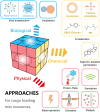Exosomes, a New Star for Targeted Delivery
- PMID: 34692704
- PMCID: PMC8531489
- DOI: 10.3389/fcell.2021.751079
Exosomes, a New Star for Targeted Delivery
Abstract
Exosomes are cell-secreted nanoparticles (generally with a size of 30-150 nm) bearing numerous biological molecules including nucleic acids, proteins and lipids, which are thought to play important roles in intercellular communication. As carriers, exosomes hold promise as advanced platforms for targeted drug/gene delivery, owing to their unique properties, such as innate stability, low immunogenicity and excellent tissue/cell penetration capacity. However, their practical applications can be limited due to insufficient targeting ability or low efficacy in some cases. In order to overcome these existing challenges, various approaches have been applied to engineer cell-derived exosomes for a higher selectivity and effectiveness. This review presents the state-of-the-art designs and applications of advanced exosome-based systems for targeted cargo delivery. By discussing experts' opinions, we hope this review will inspire the researchers in this field to develop more practical exosomal delivery systems for clinical applications.
Keywords: drug delivery; exosome engineering; exosomes; extracellular vesicles; gene delivery; targeted delivery.
Copyright © 2021 Chen, Wang, Zeng, Schwarz, Nanda, Peng and Zhou.
Conflict of interest statement
The authors declare that the research was conducted in the absence of any commercial or financial relationships that could be construed as a potential conflict of interest.
Figures







References
Publication types
LinkOut - more resources
Full Text Sources
Research Materials

